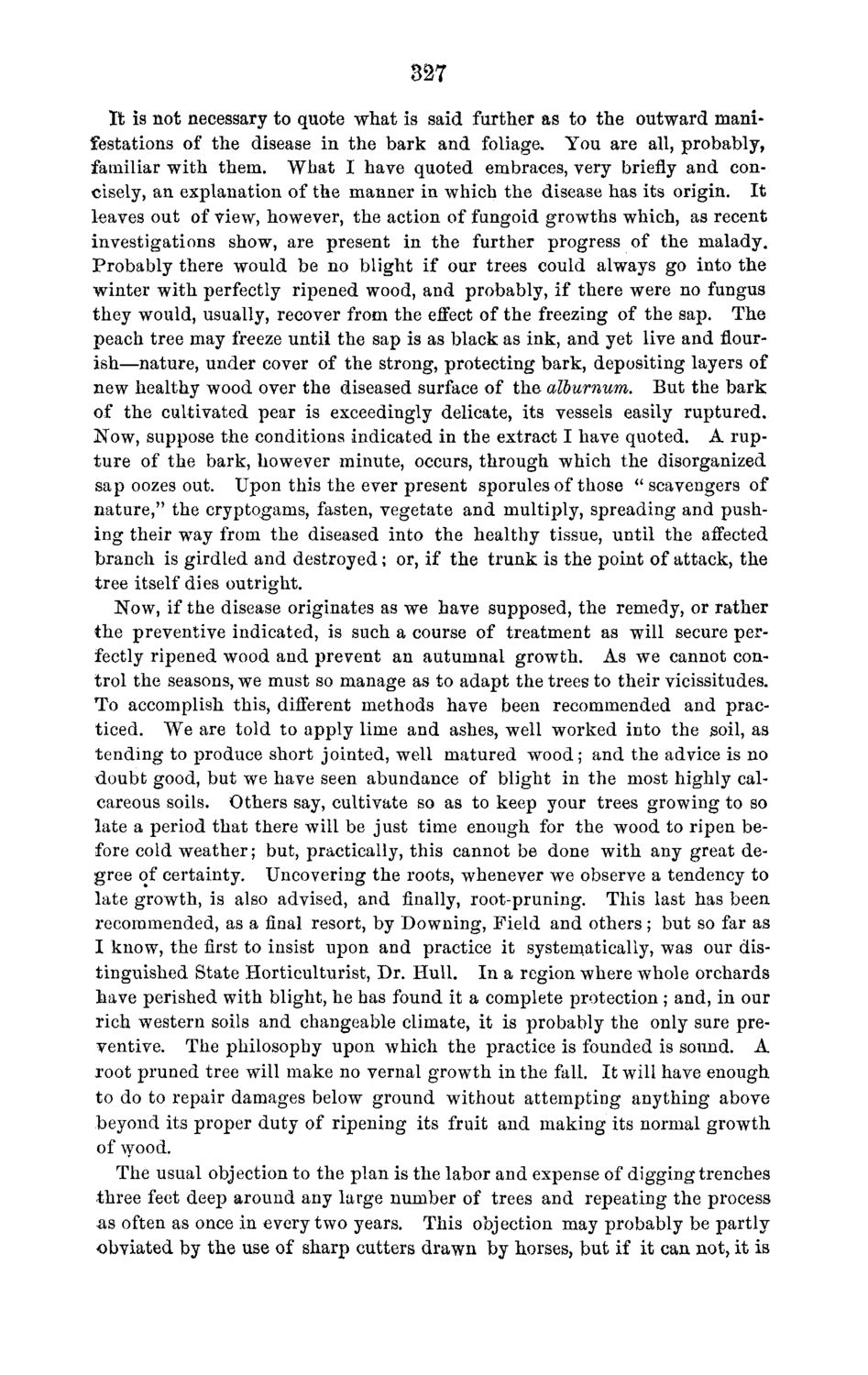| |
| |
Caption: Board of Trustees Minutes - 1870
This is a reduced-resolution page image for fast online browsing.

EXTRACTED TEXT FROM PAGE:
327 I t is not necessary to quote what is said further as to the outward manifestations of the disease in the bark and foliage. You are all, probably, familiar with them. What I have quoted embraces, very briefly and concisely, an explanation of the manner in which the disease has its origin. I t leaves out of view, however, the action of fangoid growths which, as recent investigations show, are present in the further progress of the malady. Probably there would be no blight if our trees could always go into the winter with perfectly ripened wood, and probably, if there were no fungus they would, usually, recover from the effect of the freezing of the sap. The peach tree may freeze until the sap is as black as ink, and yet live and flourish—nature, under cover of the strong, protecting bark, depositing layers of new healthy wood over the diseased surface of t h e alburnum. But the b a r k of the cultivated pear is exceedingly delicate, its vessels easily ruptured. 2STow, suppose the conditions indicated in the extract I have quoted. A rupt u r e of the bark, however minute, occurs, through which the disorganized sap oozes out. Upon this the ever present sporules of those " scavengers of nature," the cryptogams, fasten, vegetate and multiply, spreading and pushing their way from the diseased into the healthy tissue, until the affected branch is girdled and destroyed; or, if the t r u n k is the point of attack, the tree itself dies outright. Now, if the disease originates as we have supposed, the remedy, or rather the preventive indicated, is such a course of treatment as will secure perfectly ripened wood and prevent an autumnal growth. As we cannot control the seasons, we must so manage as to adapt the trees to their vicissitudes. T o accomplish this, different methods have been recommended and practiced. We are told to apply lime and ashes, well worked into the soil, as t e n d i n g to produce short jointed, well matured wood; and the advice is no doubt good, but we have seen abundance of blight in the most highly calcareous soils. Others say, cultivate so as to keep your trees growing to so late a period that there will be just time enough for the wood to ripen before cold weather; but, practically, this cannot be done with any great degree of certainty. Uncovering the roots, whenever we observe a tendency to late growth, is also advised, and finally, root-pruning. This last has been recommended, as a final resort, by Downing, Field and others; but so far as I know, the first to insist upon and practice it systematically, was our distinguished State Horticulturist, Dr. Hull. I n a region where whole orchards have perished with blight, he has found it a complete protection ; and, in our rich western soils and changeable climate, it is probably the only sure preventive. The philosophy upon which the practice is founded is sound. A root pruned tree will make no vernal growth in the fall. I t will have enough to do to repair damages below ground without attempting anything above beyond its proper duty of ripening its fruit and making its normal growth of wood. The usual objection to the plan is the labor and expense of digging trenches three feet deep around any large number of trees and repeating the process &s often as once in every two years. This objection may probably be partly obviated by t h e use of sharp cutters drawn by horses, but if it can not, it is
| |